
The ozone (whose chemical formula is O3), is an oxygen allotropic form, with the peculiar garlic smell. Its molecules, as you can understand from its formula, are made of three atoms of oxygen. So, why do we talk about it? Let’s see the pros and cons of its use in aquarium.
This article is available also in: Italian language
Let’s begin with the words of the famous marine aquariologist Anthony Rosario Calfo that in his book Book of Coral Propagation wrote about the ozone:
The ozone excess may harm or kill every organism hosted in your aquariums. But this shouldn’t prevent you from considering its use. There are many thing that can kill or harm the organisms in the aquarium. The stupidity is the number one killer of living organisms. We can call it human mistake if it makes us fell better, but it’s still ignorance given by lack of information, unverified misinformation or failure to understand correct information.
Anthony Rosario Calfo – Book of Coral Propagation – page 119
We should use this quote more often. But let’s get back to the ozone.
The ozone molecule is less stable than the oxygen and tends to change into oxygen with the liberation of the ion O-. This simple transformation leads to the increase of the oxidative capacity of the system, so to the increase of the Redox potential [or Oxidation Reduction Potential, ORP] too. The increase of the Redox leads to a greater capacity of the aquarium to oxidize the substances accelerating other processes, like the biological cycle of nitrogen. Semplifying: NH3>NO2>NO3 .

Measuring the Redox potential you can adjust in order to stay under the threshold of 375-400 mV, which isn’t harmful for any organisms, human being included. Without an ozonator, you know that your aquarium is well balanced if you measure a value included between 300 and 400.
What do we need ozone for?
The first thing you will notice when you use ozone in aquarium is that the water becomes very clear. Through the oxidation of organing compounds it bleaches and filters the water, allowing us to obtain a greater efficiency from our lights. The second thing, less obvious, is the decrease of the more sensitive bacteria and some of the pathogens.
![Ci stava bene la foto di un corallo non trovate? [Stylophora pistillata]](http://www.danireef.com/wp-content/uploads/2020/09/2020-05-acquario-marino-di-Jonathan-Betti-macro-stylophora-pistillata-Copyright-by-DaniReef-118-2.jpg)
Then why don’t we use it everyday?
The ozone has never been very popular in aquaristics, basically for two reasons.
The first one is the lack of a clear perception of a real utility, granted by documented results. There isn’t enough data to link the ozone to a good maintenance of a reef aquarium, also because we’re not willing to give credit to some far relative that has an incredible aquarium because he uses ozone. Then we have to consider, and Calfo remembers too, that the benefits of the ozone can also be obtained through other methods. For example, the use of active carbon leads to a more clear water too, and if we wanted it to be even clearer you could use zeolite. To increase the oxidation we could boost the power of the LED, and so on.
The second reason is that the ozone, in high concentrations, can be toxic both for the animals in the aquarium and the people leaving in the surroundings. That is why there’s a certain skepticism.
The ozone must always be used with active carbon, used both in water and air
The contraindications can be sum up with the formation of halogenated compounds like BrOH and BrO3– that, if not correctely removed from active carbon, can have negative repercussions on the most sensitive organisms of the the aquarium, like shrimps, small fish or at larval state, or even some coral.
In any case, the ionizer should be connected to an acrylic skimmer or suited for ozone administration, taking care to filter with active carbon every opening on the glass of the skimmer, to prevent unfiltered ozone from getting into the air. Moreover, is fundamental to track the level of ORP, that is the Redox potential, in the aquarium, so that even if you administer ozone it wouldn’t go over 375/400 mV.
The advantages given by ozone are undeniable, but it’s also true that you could obtain the same advantages with other methods. The only application I feel sure to suggest is when you have fish-only aquariums, to prevent diseases that in reef aquariums have less chances to emerge, because off the high number of corals.
What do you think?






